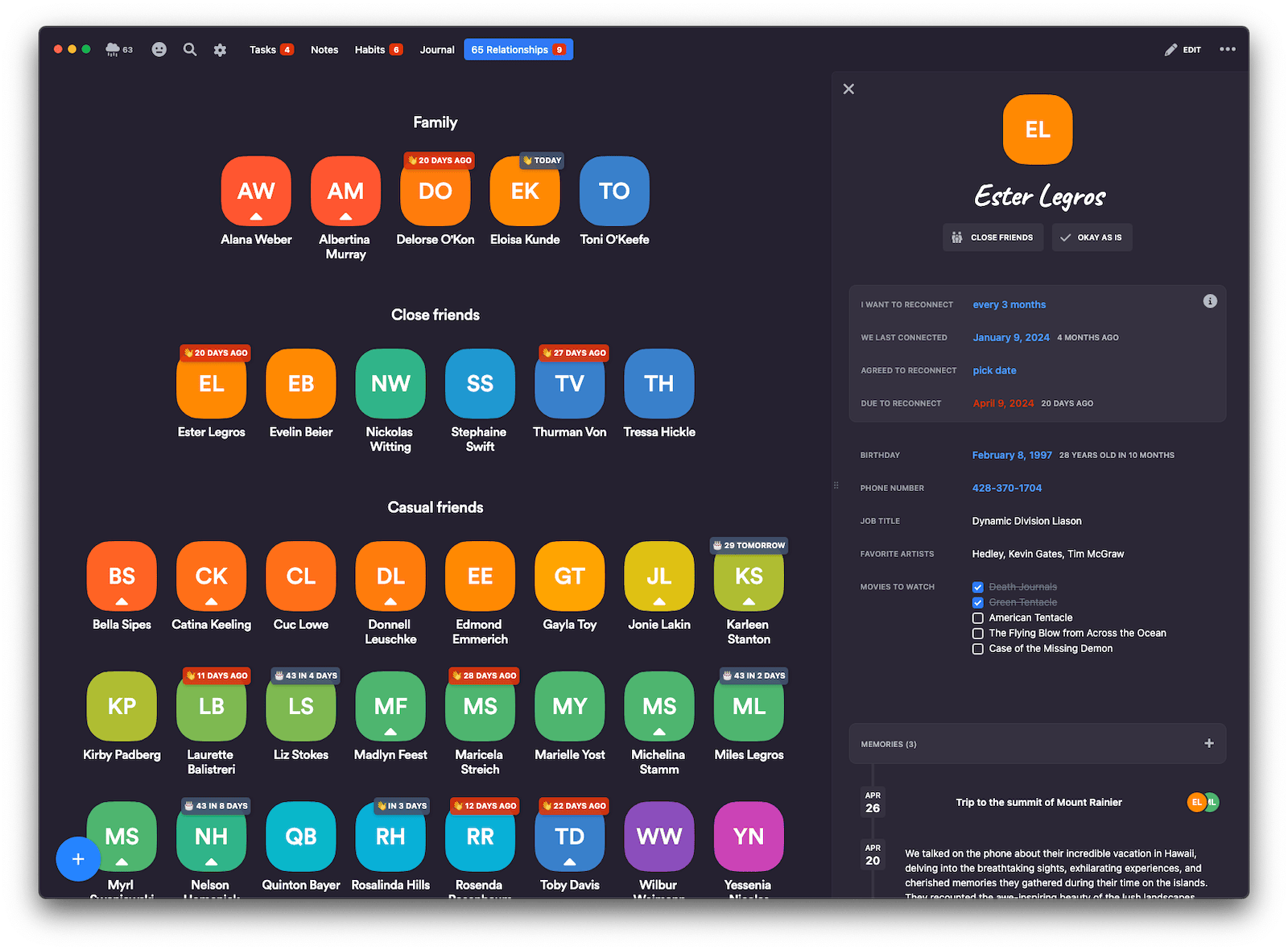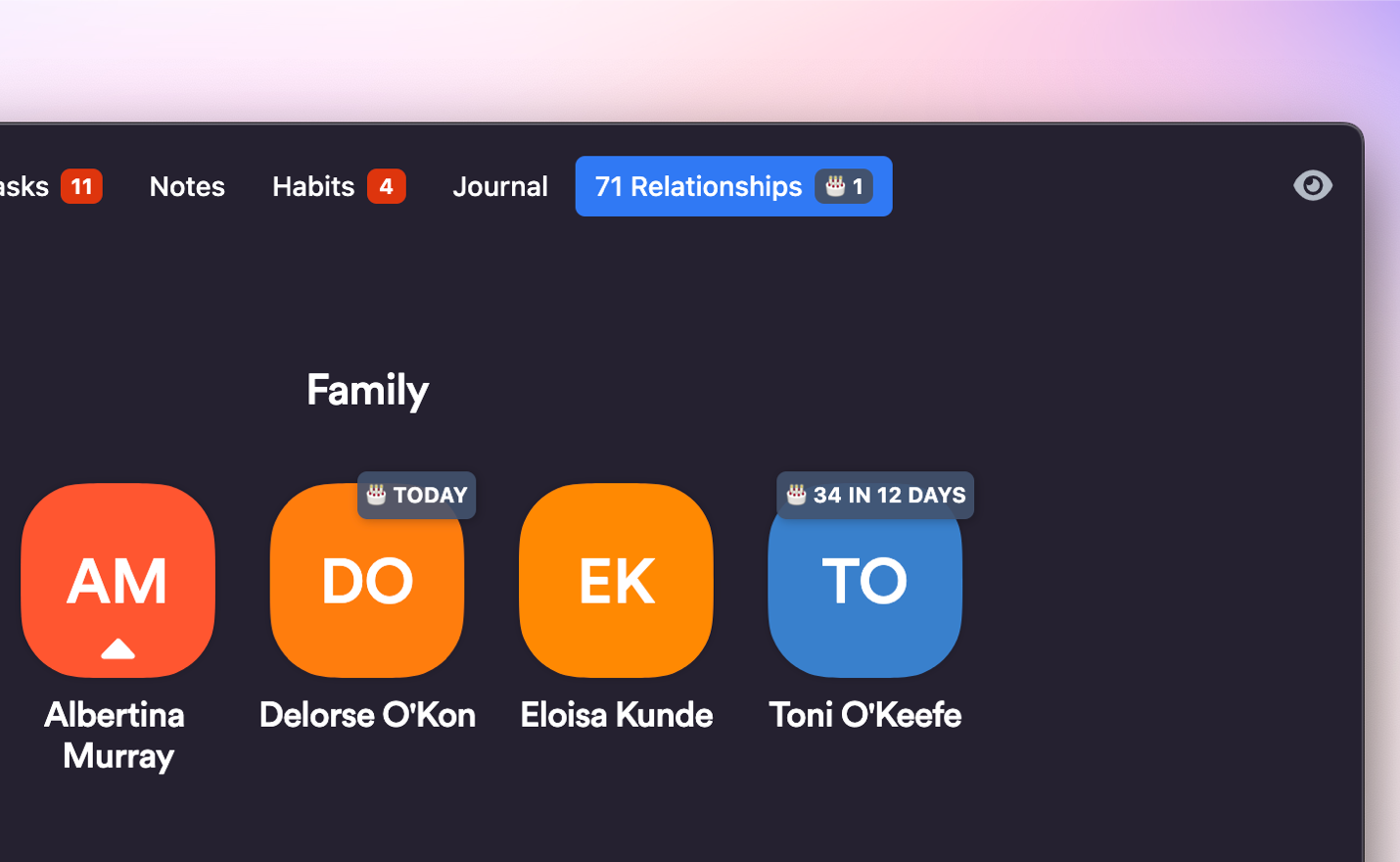Relationship Tracking
Relationship tracking is our take on a Personal CRM to help you stay in touch and build closer everlasting relationships with the people you care about the most. It's never too late to start strengthening your connections and relationships.

Why did we build this?
Despite everything and everyone being connected all the time through social networks and the internet, studies show we are becoming less socially connected over time. We replaced a few deep relationships and a sense of community and membership with many shallow and often distant connections.
In a world with so much fighting for our attention, people naturally have less time and focus on being good friends to their friends and strengthening their relationships. And it's not just you. Given the many options now on what to do with their time, people around you probably also have less time to work on their relationship with you.
Some call this a loneliness epidemic. The World Health Organization (WHO) has even declared loneliness to be a pressing global health threat, as loneliness and isolation represent profound threats to our health and well-being.
This might be an even bigger issue for people with ADHD because of their object permanence deficits and things being “out of sight, out of mind”. Unfortunately for those with ADHD, it often means unintentionally neglecting our cherished connections.

Even if you don't suffer from these and don't feel lonely, on the contrary maybe, having a place to keep all the information about your network and relationships is a great feature you don't find in similar apps.
Organization based on relationships strength
When designing Lunatask's relationship tracking feature, we wanted to create a single visualization of your network and connections where you could see everything happening around you and where everyone you know is placed based on your relationship with them. We call this a relationship hierarchy.
Relationship hierarchy
In the relationship hierarchy, people are visualized based on the closeness or strength of your relationship. Glancing at the hierarchy, you can easily see where everyone is and which relationships you want to improve. Lunatask allows you to categorize everyone into one of seven categories or groups:
- Family – Connected one way or the other for the rest of your lives
- Intimate friends – An intimate friend is someone you feel at ease with and can share almost everything that happens in your life without thinking twice
- Close friends – A close friend is someone who you want to hang out with and make an effort for this to happen
- Casual friends – Casual friends you see from time to time. They might also come and go. This is usually the largest group of people for most and also the one where there are usually most opportunities for strengthening those relationships.
- Acquaintances – Unless the person acknowledges you as a friend and you spend time together outside of the function or event that brought you together, you are an acquaintance
- Business Contacts – If you are a freelancer or work in sales, this is the place to track your business/work contacts if you wish to have them in Lunatask.
- Almost strangers – A known face you might have talked to once or twice
Individual sections of the hierarchy can be collapsed simply by clicking their name. In the filtering and display options, you can also hide family or business contacts completely so only your "friend-like" sections are displayed.
Pick relationships to work on
For each relationship in the hierarchy, you can mark whether you are happy with the relationship as is or whether it is a relationship you want to work on and improve. Those marked to improve will show an arrow pointing up in the hierarchy, so just glancing at the hierarchy, you immediately see those relationships.
If you have a free evening and are in the mood to catch up with someone, look at your relationship hierarchy, pick a relationship marked as to improve visually by looking for those with arrows, and send them a message or call them. They will surely be happy to hear from you!
Reconnect
Lunatask automatically keeps track and makes sure you connect with people at set intervals based on reconnect rules you set up for each person. Lunatask will let you know when to meet with the person again.
What reconnect means is individual to each person – it does not necessarily mean seeing each other in person.
To set up and manage this reconnect, open the person profile in relationship tracking. There, you find four fields:
- I want to reconnect – This is your reconnect rule like every month, every two weeks, or every week on Friday
- We last connected – For Lunatask to calculate the next reconnect, it needs to know when was the last time you connected
- Due to reconnect – The next reconnect date automatically calculated by Lunatask
- Agreed to reconnect – When you agree on a date to meet, you can enter it into this field here (optional). Lunatask will now calculate the next reconnect date from this date.
The Agreed to reconnect field is useful, so the red badge telling you that you are due to reconnect with this person goes away while you wait for the meeting to take place once the arrangement has been made.
How you want to treat the next reconnect date is up to you. You can treat it as the last date to reconnect on and reconnect ideally before this date (e.g. reconnect at least every three months). Or you can treat it as a reminder, don't worry about future reconnect dates, and only reach out to people after their reconnect date comes. If you want to use the second option, you can hide future reconnects in the display options.
To quickly set the last reconnect date to today, press R on your keyboard while looking at the person sidebar.
Fully customizable fields
On the level of each person or relationship, you can track any useful information you don't have space for in your memory. Those can be anniversaries, names of spouses and children, things to discuss next time you see each other, or possible activities to do together.
Available field types
The options are endless, and everyone will want to track different things. For this reason, there are no pre-defined fields when you start using our relationship tracking. It's up to you to create fields that are relevant for you. Currently, there are eight data types to choose from, and you can create as many fields as you like for each type:
- Email – An email address, clicking which opens your default email client with a new email addressed to that person
- Phone number – A phone number, clicking which offers options to either call the person or open WhatsApp chat
- Link – Any link, clicking which will open it in your default browser
- Social Profile URL – A special kind of link, for example, linking their Facebook, Twitter, or LinkedIn profiles. This is a unique field type, a link with additional functionality. For instance, in the future, having a Facebook profile linked this way will allow Lunatask to automatically fetch the person's avatar from Facebook and use it throughout Lunatask.
- Date – Any date, a one-time event. Lunatask also automatically calculates a relative distance to this date (e.g. 5 months ago or in 8 days).
- Anniversary – A date that repeats annually. Lunatask also automatically calculates how much time there is until the next anniversary.
- Birthday – A special kind of anniversary where Lunatask also automatically calculates the person's age.
- Text / Note (Markdown-enabled) – Any text or note for whatever custom information you want to track. Most of your custom fields will probably be of this time. In this field, you can add formatting you are used to in regular notes or task descriptions, including lists, checklists, etc (via Markdown syntax).
The name of each field you create can be customized, and you can name your fields however you like.
Birthdays
Lunatask keeps track of birthdays for you. You can even configure how many days ahead they should show up – pretty neat, right? You will no longer miss anyone's birthday.

Happy memories timeline
Happy memories are a way of integrating relationship tracking with journaling in Lunatask. In each person's profile, you find a timeline of happy memories you share with this person. Those can be trips or concerts you went on together, experiences you shared, or any other memories related to that person. When you open the journaling section of our app, you will also see these happy memories there among your regular journal entries.
Human memory is highly selective, and we sometimes tend to put too much emphasis on negative experiences, how lonely we feel, and how we might be missing something when we see what others do all the time on Instagram.
There's a positive psychological effect in having a timeline of happy memories and experiences we can take a look at any time. For example, at the end of the year, look at your yearly happy memories timeline and check all the great things, experiences, reconnects, and more you did through the year you might otherwise forget. Even if you are not otherwise very social, there will still be plenty of memories to cherish.
Per-person notes
You can also add notes to the memories timeline in the detail of a person. For example, after having a call with the person, you can track what you talked about on that day by adding a note to the person's memory timeline. Unlike happy memories, these notes won't show up in your journal in Lunatask.
You can use Markdown to add formatting to per-person notes.
Privacy
Relationship tracking enjoys the same security and privacy benefits as our other features. Names of people, values of all custom fields, and all your per-person notes and happy memories are end-to-end encrypted.
Furthermore, a four-digit PIN can be set up in the settings to add an extra layer of protection if someone else has access to your devices.